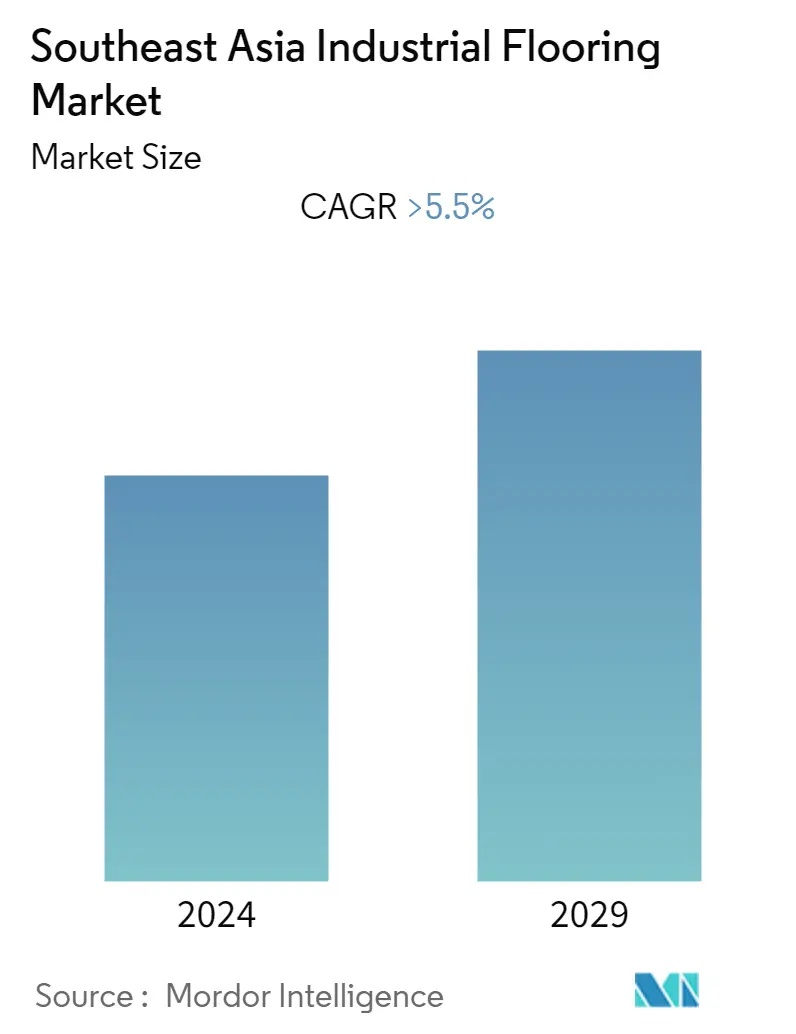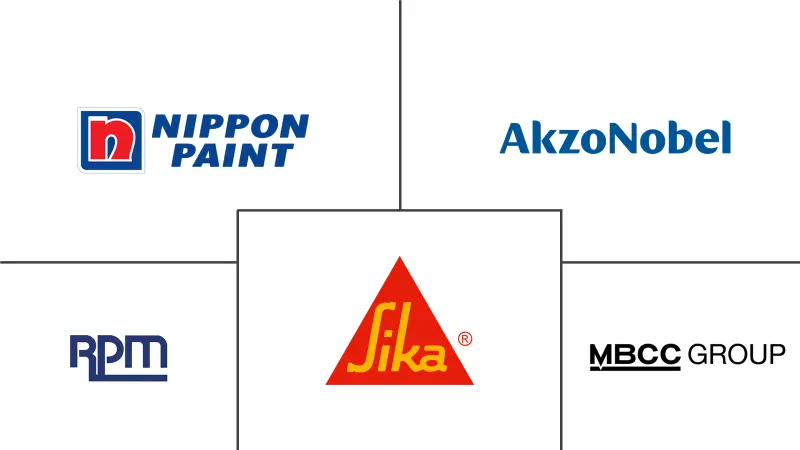Market Size of Southeast Asia Industrial Flooring Industry

| Study Period | 2019 - 2029 |
| Base Year For Estimation | 2023 |
| Forecast Data Period | 2024 - 2029 |
| Historical Data Period | 2019 - 2022 |
| CAGR | 5.50 % |
| Market Concentration | Low |
Major Players
*Disclaimer: Major Players sorted in no particular order |
Southeast Asia Industrial Flooring Market Analysis
The Southeast Asian industrial flooring market is expected to register a CAGR of over 5.5% during the forecast period.
The COVID-19 pandemic significantly affected the manufacturing and services sector. Loss of revenue and operational shutdowns were observed across various industrial sectors. Renovation and expansion projects were put on hold until the crisis was averted, and therefore, the industrial flooring market suffered greatly during the pandemic.
- However, now that the restrictions are lifted and the industrial sector is steadily recovering from the aftermath of COVID-19, increased demand for industrial flooring from the expanding food and beverage industry is expected to drive demand across the region. Rising awareness about the potential advantages of industrial flooring over normal concrete flooring is expected to strengthen this demand further.
- On the other side, stringent regulations concerning the volatile organic compounds (VOCs) emitted from industrial flooring could hinder the market's growth.
- Widening usage of polyaspartic floor coatings, given their superior properties and the growing research and development of eco-friendly bio-based flooring, could lead to future opportunities in the market.
- Across the Southeast Asian region, Indonesia could potentially lead the demand for the industrial flooring market.
Southeast Asia Industrial Flooring Industry Segmentation
Industrial flooring is a permanent cover over the concrete floor to enhance properties, such as load-bearing capacities and chemical and abrasion resistance, based on the requirement of a specific end-user industry.
The Southeast Asian industrial flooring market is segmented by resin type, application, end-user industry, and geography. By resin type, the market is segmented into epoxy, polyaspartic, polyurethane, acrylic, and other resin types. By application, the market is segmented into concrete, wood, and other applications. By end-user industry, the market is segmented into food and beverage, chemical, transportation and aviation, healthcare, and other end-user industries. The report covers market sizes and forecasts for four major countries across the region. For each segment, market sizing and forecasts have been done on the basis of revenue in USD million.
| By Resin Type | |
| Epoxy | |
| Polyaspartic | |
| Polyurethane | |
| Acrylic | |
| Other Resin Types |
| By Application | |
| Concrete | |
| Wood | |
| Other Applications |
| By End-user Industry | |
| Food and Beverage | |
| Chemical | |
| Transporation and Aviation | |
| Healthcare | |
| Other End-user Industries |
| By Geography | |
| Indonesia | |
| Thailand | |
| Vietnam | |
| Malaysia | |
| Rest of Southeast Asia |
Southeast Asia Industrial Flooring Market Size Summary
The Southeast Asian industrial flooring market is poised for significant growth, driven by the recovery of the industrial sector post-COVID-19. The pandemic had a detrimental impact on the market, causing delays in renovation and expansion projects. However, the lifting of restrictions has led to a resurgence in demand, particularly from the burgeoning food and beverage industry. This sector's expansion is expected to bolster the demand for industrial flooring, as businesses increasingly recognize the benefits of specialized flooring solutions over traditional concrete options. Despite potential challenges posed by stringent regulations on volatile organic compounds, the market is likely to benefit from innovations such as polyaspartic floor coatings and eco-friendly bio-based flooring. Indonesia is emerging as a key player in the region, with its favorable investment climate and strategic initiatives aimed at boosting the food and beverage industry.
The food and beverage sector's robust growth in Southeast Asia is attracting significant investments, with major companies expanding their operations in the region. Notable investments include the establishment of new production facilities by companies like Mr Bean and Cargill, as well as substantial funding for expansion projects by Malaysian Dairy Farm Fresh Berhad. These developments are expected to drive demand for industrial flooring solutions. Additionally, Indonesia's strategic position within ASEAN, coupled with government support for technological advancements in the food and beverage industry, further enhances its appeal to international investors. The country's ambitious targets in the automobile sector, particularly the shift towards electric vehicles, also contribute to the anticipated growth in industrial flooring demand. The market remains highly fragmented, with key players such as Sika AG, Nippon Paint Holdings Co. Ltd, and RPM International Inc. actively participating in the region's development.
Southeast Asia Industrial Flooring Market Size - Table of Contents
-
1. MARKET DYNAMICS
-
1.1 Drivers
-
1.1.1 Growing Awareness about the Advantages of Industrial Flooring
-
1.1.2 Increasing Demand from the Food and Beverage Industry
-
-
1.2 Restraints
-
1.2.1 Stringent Regulations on VOCs Released from Industrial Floorings
-
-
1.3 Industry Value-Chain Analysis
-
1.4 Porter's Five Forces Analysis
-
1.4.1 Bargaining Power of Suppliers
-
1.4.2 Bargaining Power of Buyers
-
1.4.3 Threat of New Entrants
-
1.4.4 Threat of Substitute Products and Services
-
1.4.5 Degree of Competition
-
-
-
2. MARKET SEGMENTATION (Market Size in Value)
-
2.1 By Resin Type
-
2.1.1 Epoxy
-
2.1.2 Polyaspartic
-
2.1.3 Polyurethane
-
2.1.4 Acrylic
-
2.1.5 Other Resin Types
-
-
2.2 By Application
-
2.2.1 Concrete
-
2.2.2 Wood
-
2.2.3 Other Applications
-
-
2.3 By End-user Industry
-
2.3.1 Food and Beverage
-
2.3.2 Chemical
-
2.3.3 Transporation and Aviation
-
2.3.4 Healthcare
-
2.3.5 Other End-user Industries
-
-
2.4 By Geography
-
2.4.1 Indonesia
-
2.4.2 Thailand
-
2.4.3 Vietnam
-
2.4.4 Malaysia
-
2.4.5 Rest of Southeast Asia
-
-
Southeast Asia Industrial Flooring Market Size FAQs
What is the current Southeast Asia Industrial Flooring Market size?
The Southeast Asia Industrial Flooring Market is projected to register a CAGR of greater than 5.5% during the forecast period (2024-2029)
Who are the key players in Southeast Asia Industrial Flooring Market?
Sika AG, RPM International Inc., Nippon Paint Holdings Co. Ltd., MBCC Group and Akzo Nobel N.V. are the major companies operating in the Southeast Asia Industrial Flooring Market.

